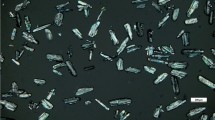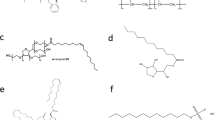ABSTRACT
Purpose
To investigate the physical processes involved in the emulsification of self-emulsifying drug delivery systems (SEDDSs) and the use of the Dynamic Gastric Model (DGM) as a characterisation tool.
Methods
SEDDSs based on soybean oil, Tween 80, Span 80 and ibuprofen were prepared and their equilibrium phase diagrams established. The emulsification behaviour in a range of media was studied using polarised light microscopy and particle sizing. The behaviour of the SEDDSs in the DGM and conventional testing equipment was assessed.
Results
A range of liquid crystalline mesophases was observed, enhanced in the presence of the drug. Polarised light microscopy showed different emulsification processes in the presence and absence of the drug, which was also manifest in different droplet sizes. The droplet size distribution varied between the DGM and the USP II dissolution apparatus.
Conclusions
The model SEDDS displays complex liquid crystalline behaviour which may be intimately involved in the emulsification process, which in turn may alter particle size on emulsification, although there remains a question as to the in vivo significance of this effect. Furthermore, we demonstrate that the DGM represents a very promising new method of assessing the biological fate of SEDDSs.








Similar content being viewed by others
Abbreviations
- AGJwp :
-
artificial gastric juice without pepsin
- DGM:
-
dynamic gastric model
- HCl:
-
hydrochloric acid
- SEDDS:
-
self-emulsifying drug delivery systems
REFERENCES
Pouton CW. Formulation of self-emulsifying drug delivery systems. Adv Drug Deliv Rev. 1997;25:47–58.
Mullertz A, Ogbonna A, Ren S, Rades T. New perspectives on lipid and surfactant based drug delivery systems for oral delivery of poorly soluble drugs. J Pharm Pharmacol. 2010;62:1622–36.
Pouton CW. Formulation of poorly water-soluble drugs for oral administration: physicochemical and physiological issues and the lipid formulation classification system. Eur J Pharm Sci. 2006;29:278–87.
MacGregor KJ, Embleton JK, Lacy JE, Perry EA, Solomon LJ, Seager H, et al. Influence of lipolysis on drug absorption from the gastro-intestinal tract. Adv Drug Deliv Rev. 1997;25:33–46.
Ito Y, Kusawake T, Prasad YVR, Sugioka N, Shibata N, Takada K. Preparation and evaluation of oral solid heparin using emulsifier and adsorbent for in vitro and in vivo studies. Int J Pharm. 2006;317:114–9.
Serratoni M, Newton M, Booth S, Clarke A. Controlled drug release from pellets containing water-insoluble drugs dissolved in a self-emulsifying system. Eur J Pharm Biopharm. 2007;65:94–8.
Charman SA, Charman WN, Rogge MC, Wilson TD, Dutko FJ, Pouton CW. Self-emulsifying drug delivery systems: formulation and biopharmaceutic evaluation of an investigational lipophilic compound. Pharm Res. 1992;9:87–93.
Craig DQM, Lievens HSR, Pitt KG, Storey DE. An investigation into the physico-chemical properties of self-emulsifying systems using low frequency dielectric spectroscopy, surface tension measurements and particle size analysis. Int J Pharm. 1993;96:147–55.
Thi TD, Van Speybroeck M, Barillaro V, Martens J, Annaert P, Augustijns P, et al. Formulate-ability of ten compounds with different physicochemical profiles in SMEDDS. Eur J Pharm Sci. 2009;38:479–88.
Tarr BD, Yalkowsky SH. Enhanced intestinal absorption of cyclosporine in rats through the reduction of emulsion droplet size. Pharm Res. 1989;6:40–3.
Kovarik JM, Mueller EA, Van Bree JB, Tetzloff W, Kutz K. Reduced inter- and intraindividual variability in cyclosporine pharmacokinetics from a microemulsion formulation. J Pharm Sci. 1994;83:444–6.
Gao Z-G, Choi H-G, Shin H-J, Park K-M, Lim S-J, Hwang K-J, et al. Physicochemical characterization and evaluation of a microemulsion system for oral delivery of cyclosporin A. Int J Pharm. 1998;161:75–86.
Khoo S-M, Humberstone AJ, Porter CJH, Edwards GA, Charman WN. Formulation design and bioavailability assessment of lipidic self-emulsifying formulations of halofantrine. Int J Pharm. 1998;167:155–64.
Holm R, Porter CJH, Edwards GA, Müllertz A, Kristensen HG, Charman WN. Examination of oral absorption and lymphatic transport of halofantrine in a triple-cannulated canine model after administration in self-microemulsifying drug delivery systems (SMEDDS) containing structured triglycerides. Eur J Pharm Sci. 2003;20:91–7.
Porter CJH, Kaukonen AM, Boyd BJ, Edwards GA, Charman WN. Susceptibility to lipase-mediated digestion reduces the oral bioavailability of danazol after administration as a medium-chain lipid-based microemulsion formulation. Pharm Res. 2004;21:1405–12.
Nielsen FS, Petersen KB, Müllertz A. Bioavailability of probucol from lipid and surfactant based formulations in minipigs: influence of droplet size and dietary state. Eur J Pharm Biopharm. 2008;69:553–62.
Porter CJH, Charman WN. In vitro assessment of oral lipid based formulations. Adv Drug Deliv Rev. 2001;50:S127–47.
O'Driscoll CM, Griffin BT. Biopharmaceutical challenges associated with drugs with low aqueous solubility–The potential impact of lipid-based formulations. Adv Drug Deliv Rev. 2008;60:617–24.
Lee KWY, Porter CJH, Boyd BJ. Gastric processing is a critical determinant of the ability of lipid-based formulations to enhance the oral bioavailability of a model poorly water-soluble drug. Transactions of the 36th Annual Meeting and Exposition of the Controlled Reslease Society, Copenhagen, Denmark; 2009, p. 681.
Grove M, Müllertz A, Pedersen GP, Nielsen JL. Bioavailability of seocalcitol: III. Administration of lipid-based formulations to minipigs in the fasted and fed state. Eur J Pharm Sci. 2007;31:8–15.
Armand M, Borel P, Pasquier B, Dubois C, Senft M, Andre M, et al. Physicochemical characteristics of emulsions during fat digestion in human stomach and duodenum. Am J Phys. 1996;271:G172–83.
Armand M, Pasquier B, Andre M, Borel P, Senft M, Peyrot J, et al. Digestion and absorption of 2 fat emulsions with different droplet sizes in the human digestive tract. Am J Clin Nutr. 1999;70:1096–106.
The Department of Health. Appendix XII B. Dissolution guidance on dissolution testing. Artificial Gastric Juice. British Pharmacopoeia 2009 Volume I & II Monographs: Medicinal and Pharmaceutical Substances. London: The Stationery Office; 2008.
Lim JC, Miller CA. Dynamic behavior and detergency in systems containing nonionic surfactants and mixtures of polar and nonpolar oils. Langmuir. 1991;7:2021–7.
Armand M, Borel P, Dubois C, Senft M, Peyrot J, Salducci J, et al. Characterization of emulsions and lipolysis of dietary lipids in the human stomach. Am J Phys. 1994;266:G372–81.
Vertzoni M, Dressman J, Butler J, Hempenstall J, Reppas C. Simulation of fasting gastric conditions and its importance for the in vivo dissolution of lipophilic compounds. Eur J Pharm Biopharm. 2005;60:413–7.
Gowland PA, Marciani L, Fillery-Travis A, Spiller RC. MRI of gastric function. In: Webb GA, Belton PS, Gil AM, and Delgadillo I, editors. Magnetic resonance in food science, a view to the future. The Royal Society of Chemistry, Cambridge; 2001. p. 85–97.
Marciani L, Bush D, Wright P, Wickham MSJ, Pick B, Wright J, et al. Monitoring of gallbladder and gastric coordination by EPI. J Magn Reson Imag. 2005;21:82–5.
Marciani L, Faulks RM, Wickham MSJ, Bush D, Pick B, Wright J, et al. Effect of intragastric acid stability of fat emulsions on gastric emptying, plasma lipid profile and postprandial satiety. Br J Nutr. 2009;101:919–28.
Marciani L, Ramanathan C, Tyler DJ, Young P, Manoj P, Wickham MSJ, et al. Fat emulsification measured using NMR transverse relaxation. J Mag Res. 2001;153:1–6.
Marciani L, Wickham MSJ, Bush D, Faulks RM, Wright J, Fillery-Travis A, et al. Magnetic resonance imaging of the behaviour of oil-in-water emulsions in the gastric lumen of man. Br J Nutr. 2006;95:331–9.
Marciani L, Wickham MSJ, Hills BP, Wright J, Bush D, Faulks RM, et al. Intragastric oil-in-water emulsion fat fraction measured using inversion recovery echo-planar magnetic resonance imaging. J Food Sci. 2004;69:E290–6.
Marciani L, Wickham MSJ, Singh G, Bush D, Pick B, Cox EF, et al. Enhancement of intragastric acid stability of a fat emulsion meal delays gastric emptying and increases cholecystokinin release and gall bladder contraction. Am J Phys. 2007;292:G1607–13.
Marciani L, Wright J, Bush D, Fillery-Travis A, Gowland PA, Spiller R. Assessment of antral grinding of a model solid meal with echo-planar imaging. Am J Phys - GI Liver Phys. 2001;280:G844–9.
Marciani L, Wickham M, Wright J, Bush D, Faulks R, Fillery-Travis A, et al. Magnetic resonance imaging (MRI) insights into how fat emulsion stability alters gastric emptying. Gastroenterology. 2003;124:A581–1.
Vardakou M. Personal communication, 2009.
Aboofazeli R, Patel N, Thomas M, Lawrence MJ. Investigations into the formation and characterization of phospholipid microemulsions. IV. Pseudo-ternary phase diagrams of systems containing water-lecithin-alcohol and oil; The influence of oil. Int J Pharm. 1995;125:107–16.
Funari SS, Klose G. Phase behaviour of the ternary system POPC/C12E2/2H2O. Chem Phys Lipids. 1995;75:145–54.
Fini A, Fazio G, Feroci G. Solubility and solubilization properties of non-steroidal anti-inflammatory drugs. Int J Pharm. 1995;126:95–102.
Stephenson BC, Rangel-Yagui CO, Junior AP, Tavares LC, Beers K, Blankschtein D. Experimental and theoretical investigation of the micellar-assisted solubilization of ibuprofen in aqueous media. Langmuir. 2006;22:1514–25.
Wakerly MG, Pouton CW, Meakin BJ, Morton FS. Self-emulsification of vegetable oil-nonionic surfactant mixtures. Phenomena in Mixed Surfactant Systems, American Chemical Society, Washington, DC; 1986. pp. 242–255.
Rosevear FB. The microscopy of the liquid crystalline neat and middle phases of soaps and synthetic detergents. J Am Oil Chem Soc. 1954;31:628–39.
ACKNOWLEDGMENTS
The authors would like to thank the University of East Anglia for the financial support of A. M. and the University of Messina for the Erasmus placement of A. P. Access to the droplet sizer was kindly provided by the Institute of Food Research (Norwich). The authors are also grateful to Dr. Mary Parker from the Institute of Food Research for assistance with the microscopy images taken with the Olympus BX60.
Author information
Authors and Affiliations
Corresponding author
Rights and permissions
About this article
Cite this article
Mercuri, A., Passalacqua, A., Wickham, M.S.J. et al. The Effect of Composition and Gastric Conditions on the Self-Emulsification Process of Ibuprofen-Loaded Self-Emulsifying Drug Delivery Systems: A Microscopic and Dynamic Gastric Model Study. Pharm Res 28, 1540–1551 (2011). https://doi.org/10.1007/s11095-011-0387-8
Received:
Accepted:
Published:
Issue Date:
DOI: https://doi.org/10.1007/s11095-011-0387-8




